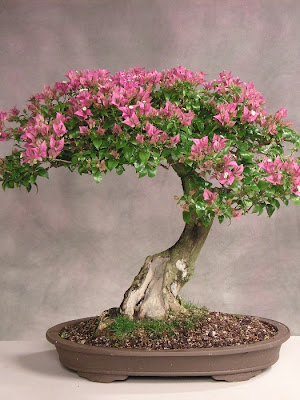Bougainvillea is semi-evergreen climbers, originated from South America. Their colorful bracts, often mistaken for flowers, vary from white, through all shades of pink to rich crimson, and are borne in late summer to early autumn. The tiny flowers are nestled in the center in these bracts.
How to produce a large mature Bonsai?
To produce a large bonsai, the plant has to be grown in open ground for many years until a thick trunk base develops, whereupon all growth is removed and the new branch structure can be grown and trained.
Where to keep Bougainvillea?
Light and Temperature:
Bougainvillea is a tropical plant that thrives in areas outdoors with low rainfall and intense heat. It prefers warmer climates and it will able to grow anywhere that has sunlight. For maximum blooming, they need maximum sunlight for at least 5 hrs per day. If all the leaves fall, the plant has become too cold or been overwatered. Move to a better position and moderate watering.
 |
| Bougainvillea Bonsai tree |
Soil:
Grow best in well-drained loamy soil(made up of equal parts of sand, silt, clay) mixed with organic matter which allows nutrients and oxygen to more easily reach the roots. Bougainvillea requires well-drained soil, so use grit as a base component. Don't use any water retaining soil it will cause root rot and leaf spots to appear.
Watering:
Bougainvillea is drought-tolerant plants and it will require less water. Keep the soil dry between waterings. Be careful not to allow your bougainvillea to sit in water as this may cause bracts to drop or stop blooming. When buds begin to swell in spring, give a thorough watering and then keep moist but never saturated.
Pruning:
Branch pruning can be carried out at any time, while the plant is semi-dormant. Prune current season's growth hard straight after flowering. Leave spring growth unchecked until the first few leaves have hardened, when they are cut back to one or two leaves. The flowering flush of growth will bear the flowers. Pruning too early will induce too much vegetative growth and too late will retard flowering.
Branch pruning can be carried out at any time, while the plant is semi-dormant. Prune current season's growth hard straight after flowering. Leave spring growth unchecked until the first few leaves have hardened, when they are cut back to one or two leaves. The flowering flush of growth will bear the flowers. Pruning too early will induce too much vegetative growth and too late will retard flowering.
Feeding:
Use a fertilizer with high in micronutrients, especially Iron to promote spectacular blooming and healthy root development. Low-nitrogen feed, while growing only feed monthly.
Style:
Being able to grow vertically and horizontally, the bougainvillea is a perfect choice for those that enjoy styling and shaping their trees. It makes a pretty and colorful bonsai tree.
Flowering:
Flowering mainly in winter and early spring. Ranging from white through yellow, orange, reds, pinks, purples. It will have some beautiful blooms. Moving your bougainvillea from one environment to another without gradual acclimatization can cause defoliation and retard flowering.
Reference:
1. https://www.bonsaiempire.com/tree-species/bougainvillea
2. Bonsai Basics by Colin Lewis.
1. https://www.bonsaiempire.com/tree-species/bougainvillea
2. Bonsai Basics by Colin Lewis.
Cây hoa giấy hấp dẫn quá, màu hoa rất đẹp và tự nhiên thật tuyệt vời , mời các bạn xem các thông tin bài viết >>> Bạn muốn làm trắng răng tự nhiên ?
ReplyDelete